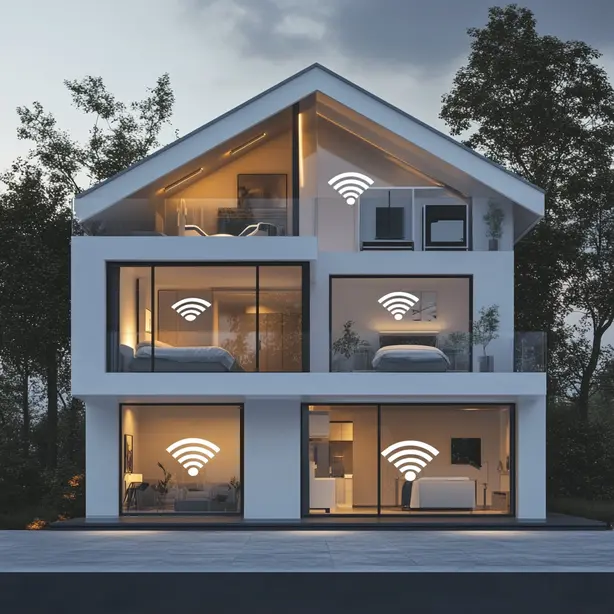Smart homes can sometimes fall short of expectations. Common issues like connectivity problems, device incompatibility, and app glitches can disrupt daily life.
Frustrating moments with voice assistants or concerns about security may also arise. While these challenges can be bothersome, there are solutions available.
Understanding these common issues can help restore smooth operation in a smart home setup.
Connectivity Issues
Connectivity issues can be frustrating, often disrupting the seamless experience that smart home technology promises.
To tackle this, start by checking your Wi-Fi network. Confirm your router is functioning properly and positioned centrally to minimize dead zones. If your devices are still struggling to connect, try rebooting them and your router. This simple step often resolves glitches.
Make sure your smart devices are within range of the Wi-Fi signal; walls and other obstructions can weaken connectivity. Additionally, verify that your firmware and software are up to date, as manufacturers release updates that enhance performance.
Device Compatibility Problems
Even with a strong Wi-Fi connection, you might run into device compatibility problems that can hinder your smart home experience.
These issues often arise when different devices use incompatible protocols, such as Zigbee, Z-Wave, or Wi-Fi. To tackle this, start by confirming that all your devices support the same communication standard.
If they don’t, consider investing in a smart home hub that can bridge these gaps. Additionally, check for firmware updates on each device, as manufacturers often release patches to improve compatibility.
If you’re still facing issues, consult the user manuals or manufacturer websites for specific compatibility lists. Being proactive about device selection and staying updated can greatly enhance your smart home setup’s functionality.
App Malfunctions
When managing a smart home, you may encounter app malfunctions that disrupt your control over devices. These issues often stem from outdated software, poor internet connectivity, or device compatibility problems.
To address this, first, check for app updates in your device’s app store and install any available updates. Next, verify your internet connection is stable by restarting your router.
If the app still misbehaves, try closing it completely and reopening it. You can also clear the app’s cache in your device settings to eliminate corrupted data.
Voice Assistant Errors
In the domain of smart homes, voice assistant errors can be particularly frustrating as they hinder your ability to control devices hands-free. These errors often stem from connectivity issues, misinterpretation of commands, or outdated software.
To tackle these problems, start by confirming your voice assistant is connected to a stable Wi-Fi network. If it’s unresponsive, try restarting the device or the associated app. Clear the cache or update the software to eliminate potential bugs.
Additionally, speak clearly and verify your commands are precise. If your device still struggles, consider reconfiguring the voice recognition settings or retraining the assistant to better understand your voice.
Following these steps can greatly enhance your smart home experience.
Security Vulnerabilities
Voice assistant errors can sometimes point to larger issues within your smart home ecosystem, particularly security vulnerabilities. These vulnerabilities can expose your devices to unauthorized access, putting your privacy at risk. Here are some common security concerns and their solutions:
| Security Issue | Solution |
|---|---|
| Weak Wi-Fi Password | Use a strong, complex password |
| Outdated Firmware | Regularly update your devices |
| Unsecured Networks | Enable WPA3 encryption |
| Default Credentials | Change default usernames/passwords |
| Insecure IoT Devices | Research device security ratings |
Sensor Calibration Problems
Although smart home sensors are designed to enhance convenience and security, they can sometimes suffer from calibration problems that lead to inaccurate readings. These issues often arise from environmental factors, such as temperature changes or interference from other devices.
To fix calibration problems, start by checking your sensor’s placement; verify it’s not obstructed or exposed to extreme conditions. Next, consult the manufacturer’s guidelines for recalibrating your device—many sensors have a reset function.
You might also consider using a calibration tool or app if available. Regular maintenance, like cleaning the sensor, can help maintain accuracy.
Wrapping Up
In summary, steering through smart home technology can be tricky, but you can tackle these common issues with a few simple steps. Strengthening your connectivity, ensuring device compatibility, updating apps, troubleshooting voice assistants, and securing your system will enhance your smart home experience. Don’t forget to regularly calibrate sensors for accurate performance. By addressing these challenges proactively, you’ll enjoy a seamless and efficient smart home that truly meets your needs.

